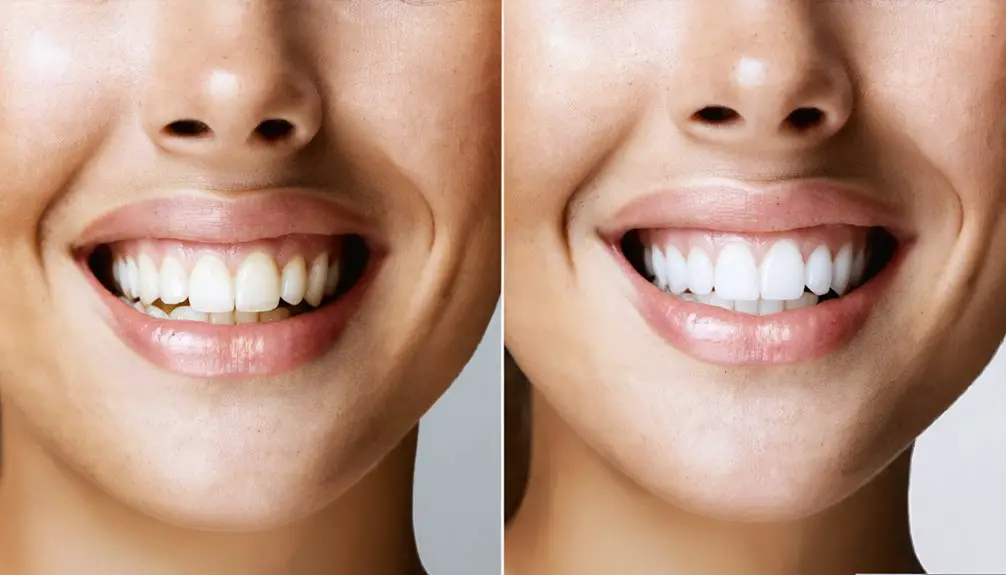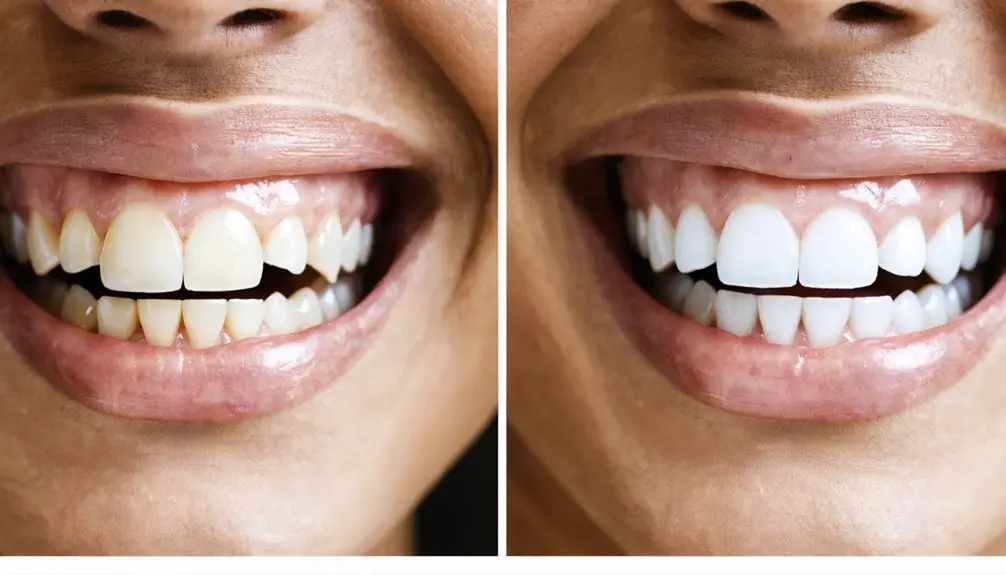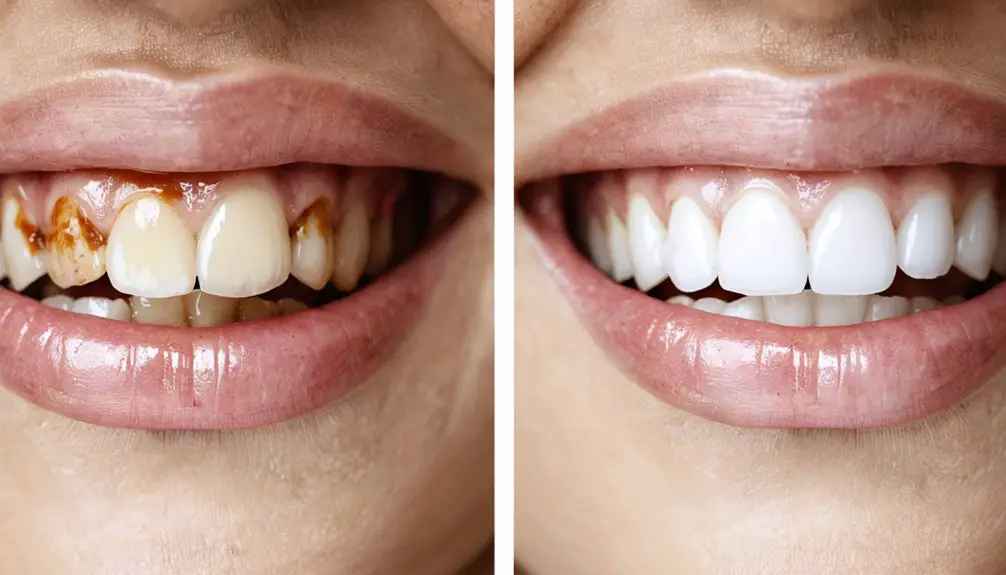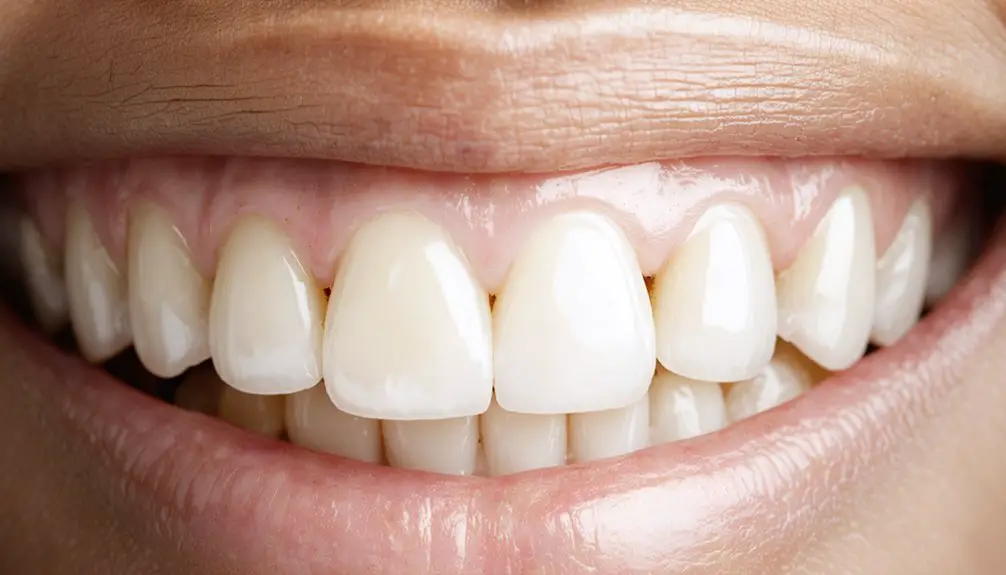You’ll see dramatic teeth whitening results through either professional or at-home treatments, with in-office procedures delivering up to 8 shades lighter in just 90 minutes. Professional options use higher peroxide concentrations (up to 40%) for faster transformation, while at-home kits offer gentler whitening over weeks with 3-10% concentrations. While both approaches work effectively, your choice depends on desired timeline, budget, and sensitivity concerns. Discover which scientifically-proven method will best transform your smile.
Key Takeaways
- Professional teeth whitening treatments can dramatically brighten teeth up to 8 shades in a single 90-minute session.
- At-home whitening kits with 10-16% carbamide peroxide provide gentle, effective results over several weeks of consistent use.
- LED and laser-activated whitening systems deliver faster results by accelerating the chemical reactions of specialized whitening gels.
- Results from professional treatments typically last over a year, while at-home options require regular touch-ups for maintenance.
- Clinical studies show best outcomes when combining in-office treatments with proper maintenance and protective measures against staining agents.
The Science Behind Teeth Whitening Success
While teeth whitening may seem like a simple cosmetic procedure, the science behind its success relies on sophisticated chemical reactions. When you apply whitening agents like hydrogen peroxide or carbamide peroxide, they trigger enzyme activity that releases free radicals, which then target both surface and deep stains within your patient’s teeth.
Understanding stain classification is essential for effective treatment. Extrinsic stains on the enamel’s surface respond differently than intrinsic stains embedded in the dentin. Professional treatments typically require a carefully monitored pH balance to prevent enamel damage. Long-term maintenance may be required as whitening effects are not permanent.
The whitening agents work by penetrating the tooth structure through microscopic channels, breaking down stubborn stain molecules through oxidation. This process alters the chromogens’ chemical structure, effectively fragmenting the pigmented compounds.
You’ll notice the whitening effect continues even after treatment as oxygen remains active within the tooth layers for up to two weeks.
Professional vs. At-Home Treatment Options
Every patient seeking teeth whitening faces a critical choice between professional treatments and at-home options.
Current teeth whitening trends show professional treatments deliver dramatic results in just 1-2 hours using 25-40% hydrogen peroxide concentrations, brightening teeth up to 8 shades. You’ll invest around $300, but gain expert supervision and customized care.
Professional teeth whitening delivers stunning results fast, brightening smiles up to 8 shades through concentrated peroxide treatments under expert care.
Whitening product reviews consistently show at-home kits, while more affordable at $50, contain 3-10% peroxide concentrations and require weeks of daily application for 3-6 shade improvements. Side effects like tooth sensitivity and gum irritation are more common with unsupervised at-home treatments.
You’ll appreciate the convenience and lower upfront cost, but results develop gradually. Patients should note that coffee and wine can quickly restain teeth after treatment.
Your choice depends on priorities: if you need rapid results and professional oversight, choose in-office treatment. If you prefer flexibility and gradual improvement at a lower cost, at-home options will serve you well.
Understanding Peroxide Concentrations and Results
When choosing a teeth whitening treatment, you’ll encounter peroxide concentrations ranging from 6% to 40%, with professional options offering the highest levels.
While store-bought products typically contain up to 10% hydrogen peroxide, professional treatments can safely utilize concentrations up to 40% under careful supervision. Common household hydrogen peroxide solutions contain 3% concentration levels.
Your choice between these options should balance the speed of desired results against potential sensitivity, as higher concentrations work faster but increase the risk of temporary tooth discomfort. Studies show at-home treatments with 10% and 16% carbamide peroxide can achieve effective whitening results while minimizing sensitivity.
Peroxide Safety Levels
Understanding peroxide concentrations is essential for safe and effective teeth whitening results. When you’re considering teeth whitening treatments, it’s vital to know that store-bought solutions typically contain 3% hydrogen peroxide, while professional treatments may use up to 40%. The American Dental Association recommends whitening products with their seal of acceptance for proven safety and efficacy.
However, peroxide regulations limit over-the-counter products to lower concentrations for your safety. Clinical studies have shown no adverse events with toothpaste containing up to 3% hydrogen peroxide.
Concentration effects directly impact both results and risks. While higher concentrations can accelerate whitening, they also increase the potential for tooth sensitivity and soft tissue irritation.
You’ll want to stay within the 3-6% range for safe at-home use, as concentrations above 6% can lead to systemic exposure beyond recommended safety thresholds.
For professional-strength treatments, always seek supervision from a dental expert who can protect your gingival tissue and monitor exposure times.
Home vs. Professional Concentrations
The stark contrast between home and professional teeth whitening concentrations markedly impacts treatment outcomes and safety considerations.
While many whitening myths suggest higher concentrations yield better results, consumer education reveals that’s not always true. You’ll find home products contain 10-16% carbamide peroxide, while professional treatments use 30-37% hydrogen peroxide concentrations.
Despite professional treatments’ higher concentrations delivering faster initial results, long-term outcomes prove similar between both options. The FDA recommends a maximum of 15% carbamide peroxide for over-the-counter products to ensure user safety. Research shows that tooth sensitivity affects 15-78% of patients using whitening treatments.
The key difference lies in application time – home treatments achieve peak results through extended wear, while professional sessions rely on shorter, intense exposure.
You’ll notice fewer sensitivity issues with home treatments’ lower concentrations, though they require more patience.
Understanding these differences helps you make informed recommendations that balance effectiveness with client comfort.
Managing Sensitivity During Whitening Treatment
If you’re worried about tooth sensitivity during whitening, you’ll find relief through proven prevention methods and home remedies.
You can greatly reduce discomfort by using desensitizing toothpaste containing potassium nitrate for 1-2 weeks before treatment and avoiding hot, cold, or acidic foods during the process.
For immediate comfort during treatment, try drinking cold beverages through a straw and consuming calcium-rich foods to strengthen your enamel.
Prevent Whitening Discomfort Today
Managing sensitivity during teeth whitening treatment doesn’t have to be a painful experience when you take proper precautions.
By implementing proven sensitivity prevention strategies and making smart whitening product selections, you’ll maximize comfort while achieving brilliant results.
Start your journey to a brighter smile with these essential steps:
- Begin using desensitizing toothpaste containing potassium nitrate 1-2 weeks before treatment to block nerve pathways.
- Choose whitening products with lower peroxide concentrations (5-6%) specifically formulated for sensitive teeth.
- Apply professional fluoride treatments or varnishes to strengthen enamel and provide lasting protection.
Maintain comfort by drinking through straws, avoiding temperature extremes, and consuming calcium-rich foods post-treatment.
Remember to rinse with fluoride mouthwash and continue using desensitizing products for best results.
Home Remedies Combat Sensitivity
Natural remedies and at-home solutions provide effective relief for sensitivity during teeth whitening treatments. You’ll find immediate comfort using warm saltwater rinses – mix half a teaspoon of salt in 8 ounces of water and swish for 30 seconds to reduce inflammation. This natural remedy can be repeated several times daily for consistent sensitivity relief.
Support your enamel’s recovery by choosing room temperature beverages and calcium-rich foods like yogurt and cheese. Protect sensitive areas by using a soft-bristled toothbrush with gentle motions, and switch to non-abrasive toothpaste containing potassium nitrate or strontium chloride. These ingredients effectively block nerve pathways causing discomfort.
For enhanced protection, consider hydroxyapatite toothpaste, which forms a protective barrier around your teeth. Remember to avoid acidic foods and extreme temperatures while managing sensitivity during your whitening journey.
Latest Innovations in Whitening Technology

While traditional teeth whitening methods remain popular, recent technological breakthroughs have revolutionized the industry with more efficient, comfortable, and personalized solutions.
Today’s whitening technologies combine AI-driven treatment planning, laser-assisted procedures, and innovative formulations to deliver exceptional results while prioritizing your comfort and safety.
- Advanced LED and laser systems now activate specialized whitening gels faster, producing dramatic results in single appointments while minimizing sensitivity.
- AI-powered digital imaging helps track your progress and customize treatments, ensuring ideal outcomes through precise shade matching.
- New formulations feature stabilized peroxide compounds and desensitizing agents, offering professional-strength whitening with enhanced enamel protection.
These innovations have transformed teeth whitening into a more predictable, comfortable experience that you can confidently recommend to those seeking brighter smiles.
Choosing the Right Whitening Method for You
When deciding between professional and at-home teeth whitening, you’ll need to weigh factors like the severity of your stains, desired timeline, and budget constraints.
Professional treatments offer dramatic results of up to 8 shades lighter in 90 minutes under careful supervision, while at-home options provide gentler whitening over several weeks at a lower cost.
Your tooth sensitivity and enamel condition should guide your choice, as professional treatments use stronger peroxide concentrations that may require specialized precautions to manage discomfort.
Professional Vs Home Treatment
Before choosing between professional and at-home teeth whitening treatments, you’ll need to weigh several key factors that impact both your results and investment.
Professional benefits include stronger peroxide agents that penetrate deeper into enamel, delivering up to 8 shades lighter in just one hour. While home convenience allows flexible scheduling, results take weeks and typically achieve only 3-6 shades of improvement.
Consider these critical differences:
- Time investment: One 2-hour professional session vs. weeks of daily home applications
- Results longevity: Professional treatments last over a year, while home kits require frequent touch-ups
- Cost structure: $300+ for lasting professional results vs. $50 per kit with potential need for multiple purchases
Your decision should align with your whitening goals, timeline, and budget while considering the value of professional supervision.
Safety and Sensitivity Factors
Although teeth whitening procedures are generally safe and effective, understanding potential sensitivity issues is essential for selecting the right treatment approach.
You’ll need to take into account that over 50% of patients experience some level of sensitivity, though it’s typically mild and resolves within 24 hours.
If you’re prone to tooth sensitivity or have gum recession, you’ll want to opt for lower peroxide concentrations (10-16% carbamide peroxide) in your whitening protocols.
These gentler formulations can still achieve excellent results while minimizing discomfort. For ideal sensitivity management, look for products containing desensitizing agents like fluoride or potassium nitrate.
Remember to avoid acidic foods post-treatment and think about using desensitizing toothpaste during your whitening process.
If severe sensitivity occurs, adjusting your treatment schedule or consulting a dental professional can help customize a more comfortable approach.
Social Media’s Impact on Whitening Trends

Since the rise of social media platforms, teeth whitening has transformed from a purely cosmetic procedure into a cultural phenomenon driven by digital influence.
Social media trends have revolutionized how consumers approach teeth whitening, with platforms like Instagram and TikTok showcasing dramatic before-and-after transformations. The influencer impact has created unprecedented demand for at-home whitening solutions, particularly among younger demographics.
Key shifts in consumer behavior include:
- Increased expectations for immediate, photo-ready results
- Growing preference for convenient, portable whitening options
- Higher engagement with subscription-based whitening services
This digital transformation has made teeth whitening more accessible than ever, though it’s important to balance social media enthusiasm with realistic clinical outcomes and proper safety protocols.
Clinical Studies and Safety Evidence
Extensive clinical research has validated both the efficacy and safety parameters of modern teeth whitening treatments.
You’ll find that contrary to common whitening myths, supervised procedures using appropriate concentrations are remarkably safe. Clinical studies show that while higher peroxide levels (35-40%) deliver faster results, they’re also linked to increased sensitivity.
Clinical evidence confirms that professional teeth whitening is safe, though stronger peroxide concentrations may cause temporary tooth sensitivity.
For ideal outcomes with minimal discomfort, you should consider that lower concentration at-home treatments (10-16% carbamide peroxide) achieve comparable long-term results to in-office procedures.
Consumer awareness is essential – while over-the-counter products are readily available, their efficacy varies considerably. Dentist-supervised treatments consistently outperform OTC alternatives, particularly regarding color stability and predictable results.
Light-activated systems, despite their popularity, haven’t demonstrated superior whitening benefits and may increase sensitivity risks.
Global Market Growth and Consumer Preferences

Beyond clinical safety considerations, the teeth whitening market continues to experience remarkable growth worldwide. Consumer awareness and market expansion are projected to drive the industry from USD 8.52 billion to nearly USD 13 billion by 2033.
You’ll find the Asia Pacific region leading with a 33.8% market share, while North America dominates in overall spending.
Your patients are increasingly gravitating toward:
- Affordable at-home solutions, particularly whitening toothpastes and pens
- Non-invasive treatments offering quick results
- Products formulated for sensitivity concerns, including peroxide-free options
As a practitioner, you’ll notice how social media influences and digital marketing are reshaping consumer preferences.
The surge in demand for LED-enhanced devices and professional-grade features in at-home products reflects your patients’ growing sophistication in oral aesthetics.
Maximizing Long-Term Whitening Results
While achieving bright, white teeth marks an important milestone, maintaining those results requires a strategic approach combining clinical protocols and lifestyle modifications.
Getting whiter teeth is just the beginning – keeping them bright demands both professional care and meaningful lifestyle changes.
You’ll maximize your whitening maintenance through targeted lifestyle changes that limit exposure to staining agents like coffee, tea, and red wine. Professional supervision guarantees ideal results, as higher-concentration treatments performed safely can deliver lasting effects when combined with periodic touch-ups.
You’ll want to incorporate protective measures, including fluoride treatments and consistent oral hygiene, to preserve your enamel’s integrity. Regular dental cleanings remove surface stains before they penetrate deeper.
For best results, consider combining in-office treatments with at-home maintenance protocols. Remember, initial color regression may occur within weeks, but proper care and occasional touch-ups will help sustain your bright smile long-term.
Frequently Asked Questions
Can Whitening Damage Existing Dental Work Like Crowns, Veneers, or Fillings?
Yes, whitening agents can soften your dental restorations’ surfaces, potentially reducing their longevity. You’ll also notice color mismatches since crowns, veneers, and fillings won’t whiten like natural teeth.
How Long Should I Wait After Teeth Cleaning Before Starting Whitening Treatment?
You don’t need a waiting period after dental hygiene cleaning. You can start whitening immediately, as clean teeth actually enhance the treatment’s effectiveness and help achieve more uniform results.
Will Smoking or Vaping Affect the Success of Teeth Whitening Procedures?
Smokers need whitening treatments 2-3 times more frequently than non-smokers. Both smoking effects and vaping impact will considerably reduce your whitening results by causing persistent stains and weakening your enamel’s response to treatment.
Are Natural Alternatives Like Charcoal or Coconut Oil Effective for Teeth Whitening?
You won’t get significant results from natural alternatives. Charcoal effectiveness is minimal and risks enamel damage, while coconut oil efficacy lacks scientific proof. Stick with dentist-approved whitening methods for safe results.
Can Teenagers Safely Undergo Professional Teeth Whitening Treatments?
While you might worry about sensitivity, you can safely whiten your teen’s teeth from age 14 with proper dental supervision. Following safety guidelines, professional treatments protect teenage dental health better than over-the-counter options.
References
- https://www.loudfamilydentistry.com/blog/teeth-whitening-related-statistics-on-effectiveness-and-sensitivity-incidence
- https://www.fortunebusinessinsights.com/teeth-whitening-market-110349
- https://www.futuremarketinsights.com/reports/teeth-whitening-pens-market
- https://pmc.ncbi.nlm.nih.gov/articles/PMC4058574/
- https://www.archivemarketresearch.com/reports/teeth-whitening-534836
- https://sandlakedental.com/blog/understanding-the-science-behind-teeth-whitening/
- https://verodentalspa.com/blog/the-science-of-tooth-whitening/
- https://pocketdentistry.com/the-science-of-tooth-whitening/
- https://www.champaigndentalgroup.org/about-us/blog-articles/how-teeth-whitening-works-the-science-behind-brighter-smiles
- https://www.veenstradental.com/blog/at-home-vs-professional-teeth-whiteningwhats-the-difference-



